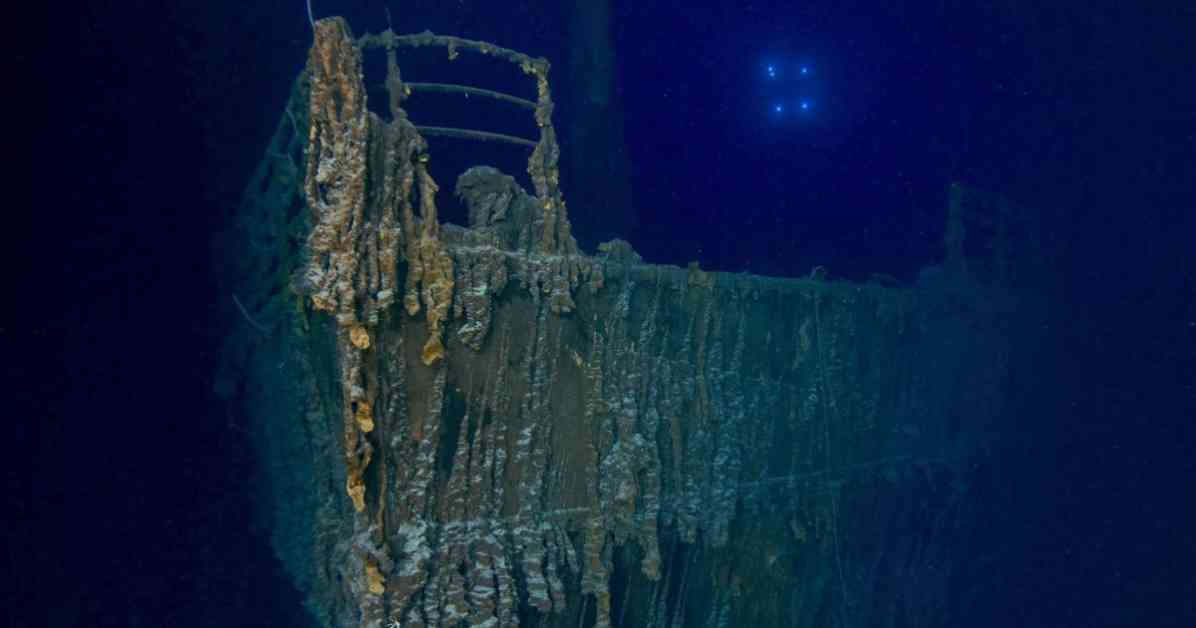New Discoveries of Titanic’s Deterioration: Unveiling the Ship’s Decay
New images of the Titanic have recently been released, showcasing the ongoing decay of the iconic ship as well as the rediscovery of a significant bronze statue. These images, captured by robots during dives conducted this summer, highlight the deteriorating state of the vessel, with a section of the railing on the bow seen to have fallen off since the last photos were taken in 2022. In a surprising find, a bronze statue of Diana of Versailles, which was originally located in the first class lounge, was spotted lying face up on the sea bed. This statue was last photographed in 1986 by Robert Ballard, the explorer who had discovered the Titanic wreck a year earlier.
The bow of the Titanic, with its iconic railings, holds a special place in popular culture, immortalized by the memorable scenes from James Cameron’s blockbuster film “Titanic.” Tomasina Ray, the director of collections at RMS Titanic Inc, the company behind the recent expedition, expressed her thoughts on the deteriorating state of the ship. She mentioned, “The bow of Titanic is just iconic – you have all these moments in pop culture – and that’s what you think of when you think of the shipwreck. And it doesn’t look like that anymore. It’s just another reminder of the deterioration that’s happening every day.”
The recent images reveal not only the fallen railing on the bow but also the gradual decay of the entire metal structure of the Titanic. Microbes are slowly eating away at the ship, creating rusticles that contribute to its disintegration. Previous dives in 2019 had shown the collapse of the starboard side of the officers’ quarters, leading to the destruction of state rooms and a glimpse of the captain’s bathtub. The latest dives conducted in July and August utilized remotely operated vehicles (ROVs) to capture over two million images and 24 hours of high-definition footage of the wreck, located 3,800 meters below the surface.
When the Titanic sank in 1912, it split into two sections, with the bow and stern lying approximately 800 meters apart, surrounded by debris. Among this debris was the Diana of Versailles statue, measuring 60cm in height. James Penca, a Titanic researcher and podcast presenter, described the rediscovery of the statue as a significant moment. He explained how the first-class lounge, where the statue was originally placed, was torn open during the ship’s breakup, causing Diana to be lost in the darkness of the debris field. The first-class lounge itself was described as the most beautiful and detailed room on the ship, with the Diana of Versailles serving as its centerpiece.
RMS Titanic Inc, the only company authorized to recover parts of the Titanic wreck, has retrieved numerous items over the years for display around the world. Their future plans include returning to the site to salvage more artifacts, including the bronze statue of Diana. However, some critics, such as Pablo O’Hana from the Titanic podcast “Unsinkable,” have raised concerns about the continued removal of objects from the site. O’Hana emphasized the importance of preserving the historic site and suggested the establishment of an independent committee to oversee future expeditions.
Despite the differing opinions on salvaging artifacts from the Titanic wreck, the rediscovery of the Diana of Versailles statue has sparked discussions about the value of bringing such pieces of art back to the surface for public viewing. James, the Titanic researcher, highlighted the educational and historical significance of showcasing the statue to inspire a love for history, diving, conservation, and maritime heritage. He argued that leaving artifacts on the ocean floor would deprive people of the opportunity to engage with and appreciate these cultural treasures.
In conclusion, the recent images of the Titanic’s deterioration and the rediscovery of the bronze statue of Diana of Versailles offer a glimpse into the ongoing changes taking place at the historic wreck site. As debates continue over the best approach to preserving and honoring the legacy of the Titanic, the importance of balancing exploration with conservation remains a key consideration for future expeditions. The story of the Titanic, its passengers, and its artifacts continue to captivate the world, serving as a reminder of the fragility of human endeavors in the face of nature’s relentless forces.













